
- SAP Community
- Products and Technology
- Technology
- Technology Blogs by SAP
- Migration tool in Cloud Integration Capability of ...
- Subscribe to RSS Feed
- Mark as New
- Mark as Read
- Bookmark
- Subscribe
- Printer Friendly Page
- Report Inappropriate Content
Introduction
The January 2023 release of SAP Integration Suite now provides a feature in the Cloud Integration capability (6.35.*) to semi-automate the migration of integration scenarios from SAP Process Orchestration to SAP Integration Suite.
New with SAP Cloud Integration capability release (6.45.x) of SAP Integration Suite
The November 2023 release of Cloud Integration in SAP Integration Suite now provides an enhancement in the Migration Tool. Please refer the section - "SAP Cloud Integration release 6.45.x" in this blog.
New with SAP Cloud Integration capability release (6.44.x) of SAP Integration Suite
The October 2023 release of Cloud Integration in SAP Integration Suite now provides an enhancement in the Migration Tool. Please refer the section - "SAP Cloud Integration release 6.44.x" in this blog.
New with SAP Cloud Integration capability release (6.43.x) of SAP Integration Suite
The September 2023 release of Cloud Integration in SAP Integration Suite now provides an enhancement in the Migration Tool. Please refer the section - "SAP Cloud Integration release 6.43.x" in this blog.
New with SAP Cloud Integration capability release (6.41.x) of SAP Integration Suite
The July 2023 release of Cloud Integration in SAP Integration Suite now provides an enhancement in the Migration Tool. Please refer the section - "SAP Cloud Integration release 6.41.x" in this blog.
New with SAP Cloud Integration capability release (6.40.x) of SAP Integration Suite
The June 2023 release of Cloud Integration in SAP Integration Suite now provides an enhancement in the Migration Tool. Please refer the section - "SAP Cloud Integration release 6.40.x" in this blog.
New with SAP Cloud Integration capability release (6.39.x) of SAP Integration Suite
The May 2023 release of Cloud Integration in SAP Integration Suite now provides an enhancement in the Migration Tool. Please refer the section - "SAP Cloud Integration release 6.39.x" in this blog.
New with SAP Cloud Integration capability release (6.38.x) of SAP Integration Suite
The April 2023 release of Cloud Integration in SAP Integration Suite now provides an enhancement in the Migration Tool. Please refer the section - "SAP Cloud Integration release 6.38.x" in this blog.
New with SAP Cloud Integration capability release (6.37.x) of SAP Integration Suite
The March 2023 release of Cloud Integration in SAP Integration Suite now provides an enhancement in the Migration Tool. Please refer the section - "SAP Cloud Integration release 6.37.x" in this blog.
New with SAP Cloud Integration capability release (6.36.x) of SAP Integration Suite
The February 2023 release of Cloud Integration in SAP Integration Suite now provides an enhancement in the Migration Tool. Please refer the section - "SAP Cloud Integration release 6.36.x" in this blog.
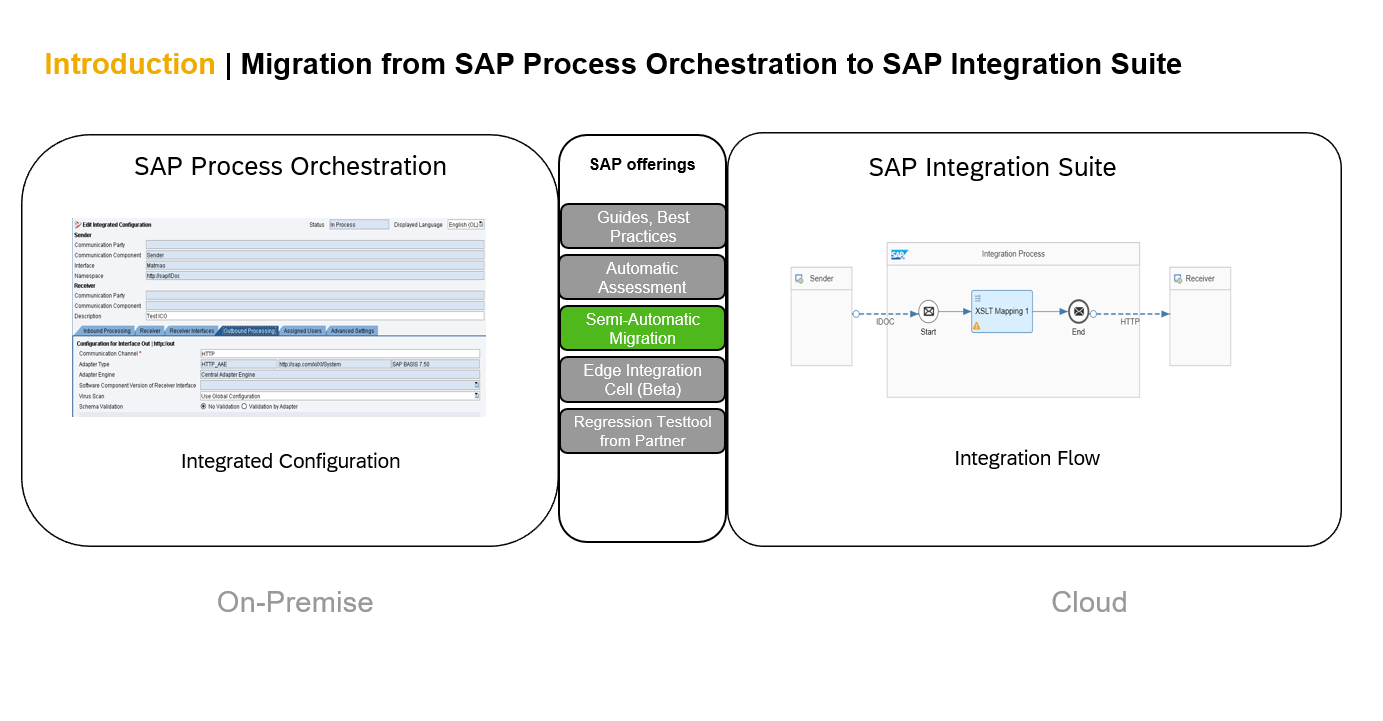
This feature is described as Migration tooling in the SAP Help Portal (see documentation). Please note, this feature is available across all the editions of SAP Integration Suite editions except Basic and SFSF editions. Please refer the SAP Note 2903776 for more details. Role collection mandated for consuming this feature is "PI_Integration_Developer". Refer the help document for more details Persona | SAP Help Portal.
What is the Migration tool?
Migration Tooling is a feature in the Cloud Integration capability of the SAP Integration Suite that enables you to semi-automate the migrations of integration scenarios from SAP Process Orchestration to SAP Integration Suite. Before you migrate an integration scenario, it is important to assess the migration of the integration scenarios using the Migration Assessment capability of SAP Integration Suite. For more information, see, Migration Assessment documentation and SAP blog.
Why use the Migration tool?
Migrating integration scenarios manually from SAP Process Orchestration to SAP Integration Suite can be an error prone process and may require a significant investment in human effort. SAP Process Orchestration customers have made significant investment over many years and in order to be able to take advantage of all the new innovation in SAP Integration Suite, it was imperative that we deliver migration tool to help automate this process as much as possible.
The Migration tool will automatically create interfaces in SAP Cloud Integration based on design time artifacts in SAP Process Orchestration based on current scenarios supported through a template-based process. For cases where the artifacts match scenarios supported, much of the migration may be automated, with some manually changes still possibly required. The goal with the migration tool is to ultimately delivery a migration time savings of approximately 60-70 % through automation.
How to use the Migration tool?
In this section, we will explain how to use this feature and leverage the benefits to migrate SAP Process Orchestration integration scenarios. Before that, you should be well versed with certain key aspects, pre-requisites, and boundary conditions:
- Which version of SAP Process Orchestration is supported?
- How to add and configure SAP Process Orchestration system?
- Which SAP Process Orchestration objects are support for semi-automated migration?
- How to assess your SAP Process Orchestration artifacts using the migration assessment tool prior scenario migration?
- Which of the scenarios, for supported objects, can the migration tool migrate based on the currently delivered templates?
Which version of SAP Process Orchestration is supported?
Migration is currently supported only for SAP Process Orchestration 7.5 SP06 and above.
How to add and configure an SAP Process Orchestration system?
You can refer to the documentation to learn how to establish a connection between your SAP Process Orchestration system and the SAP Integration Suite Migration tool so to fetch the SAP Process Orchestration objects from Integration Directory and Enterprise Service Repository.
Which SAP Process Orchestration integration objects are supported semi-automated migration?
Currently, migration of Integrated Configuration Object (ICO) is supported.
How to assess your SAP Process Orchestration artifacts using the migration assessment tool prior scenario migration?
Before doing a migration, it is important to assess the integration scenarios in SAP Process Orchestration. Migration Assessment is a new feature of the Cloud Integration capability of SAP Integration Suite. This feature helps you to estimate the technical efforts involved in the migration process and evaluates how various integration scenarios can be migrated.
You can refer to the documentation to learn in more detail about the Migration Assessment feature:
After running the assessment each object (ICO) will be assigned a migration status. The possible migration statuses for ICOs are Evaluation required, Adjustment required, and Ready to migrate. For details about each status, see Concepts. In the current scope, migration is supported only for ICOs that are in Adjustment required and Ready to migrate statuses.
Which of the scenarios, for supported objects, can the migration tool migrate based on the currently delivered templates?
Integration scenarios in the SAP Process Orchestration system map to integration scenario patterns. Each pattern has been analysed and matched against scenario templates delivered as part of the migration tool in cloud integration.
Every Integration Configuration Object (ICO) that can be migrated has an associated template in the migration tool. Based on the information we provide in the templates; the migration tool is able to create the equivalent integration flows in SAP Integration Suite.
We’ve covered many important points on what this tool is and how it works, now let’s go through the experience of scenario migration by using the Migration tool.
In the steps below, I will explain how we can migrate a point-to-point async scenario which has SOAP adapters and mapping steps in the form of message mapping and XSLT mapping.
You can migrate the integration scenario of your choice, but please make yourself aware of the supported components, templates and known limitations.
Step 1: Open SAP Integration Suite launchpad, navigate to design workspace of integrations and then create or open any existing integration package.

Step 2: Edit the integration package. The migrate button will then be visible to migrate integration scenarios from SAP Process Orchestration to SAP Integration Suite.
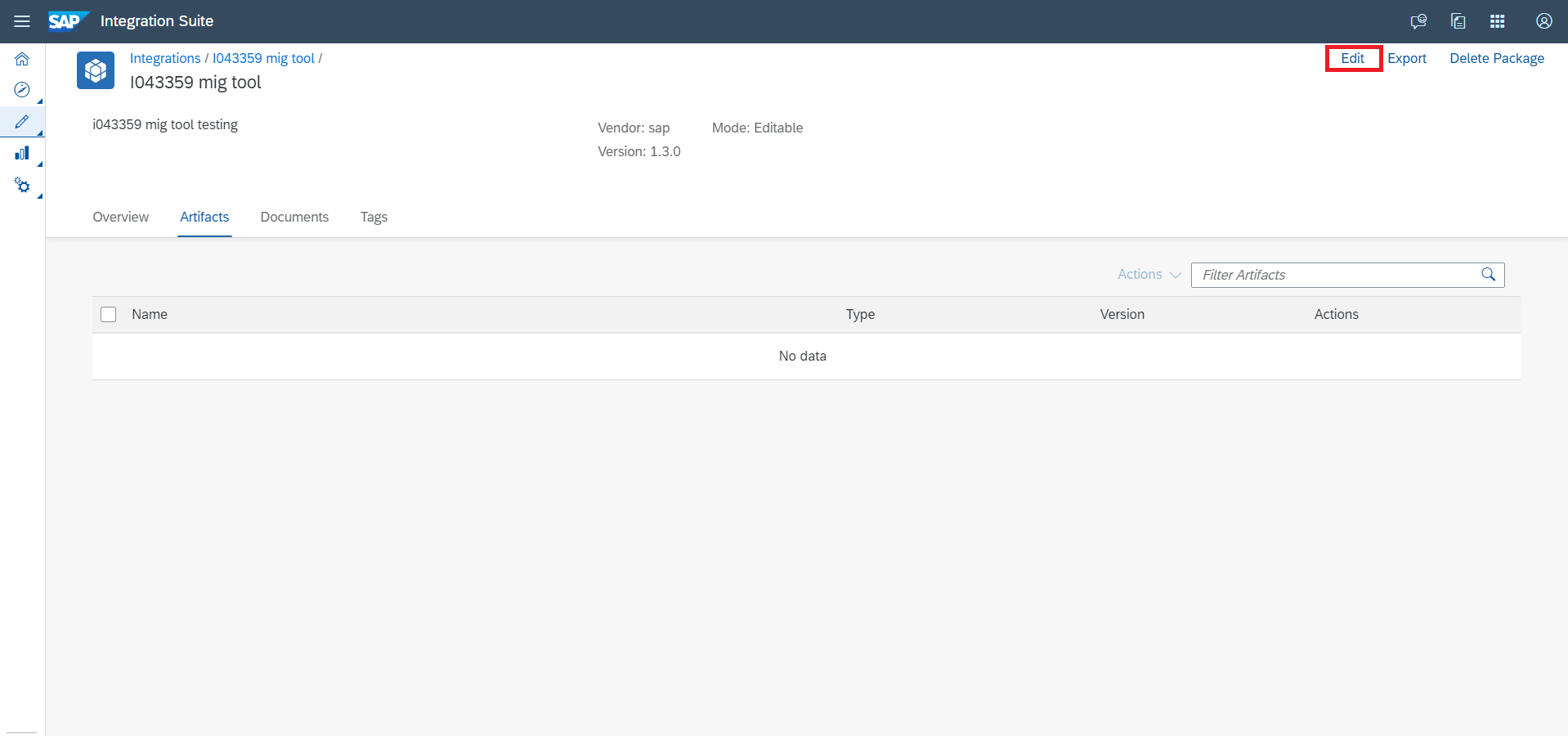
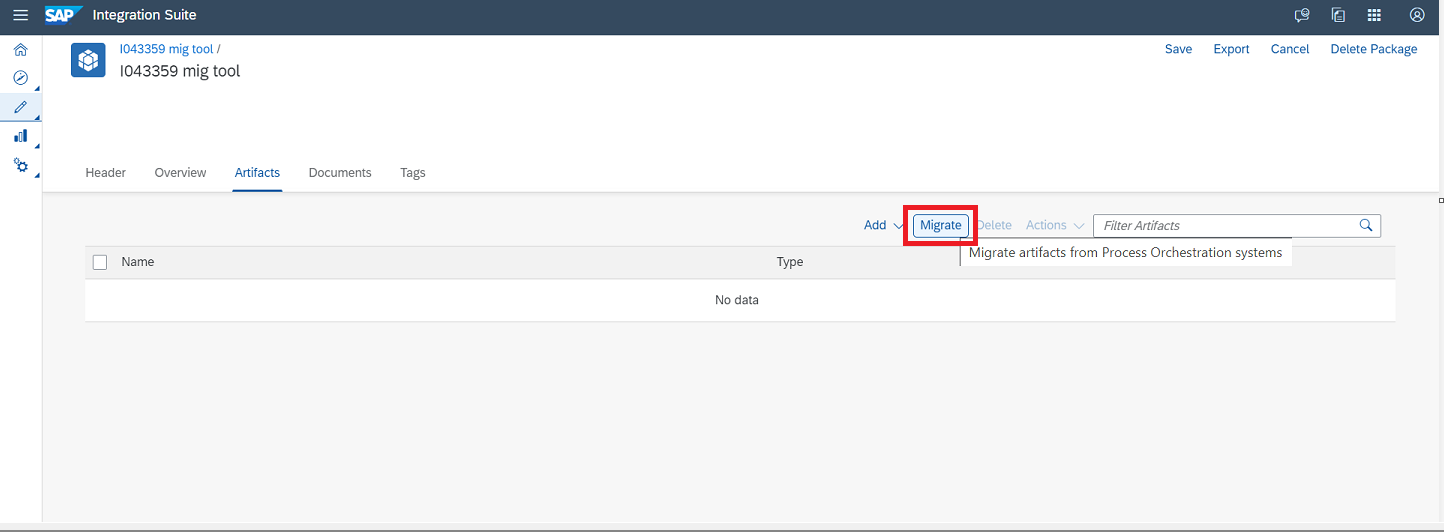
Step 3: Click the "Migrate” button and the Migration tool will appear which will provide a guided tour through the scenario migration. First select an SAP Process Orchestration System.
Step 4: Select the SAP Process Orchestration system and establish the connection. The SAP Process Orchestration systems which were added as a part of Add an SAP Process Orchestration System are listed here.

Step 5: Click the “Connect” button to establish the connection. The “Next Step” button in the footer will be enabled if the connection is established successfully.
Step 6: Select the ICO that you wish to migrate from the SAP Process Orchestration Artifacts tab. You will see all the ICOs are fetched from the Integration Directory of the SAP Process Orchestration system. The "Type” selected is “Integration Configuration Object”, which is the only SAP Process Orchestration object supported in this release of the Migration tool.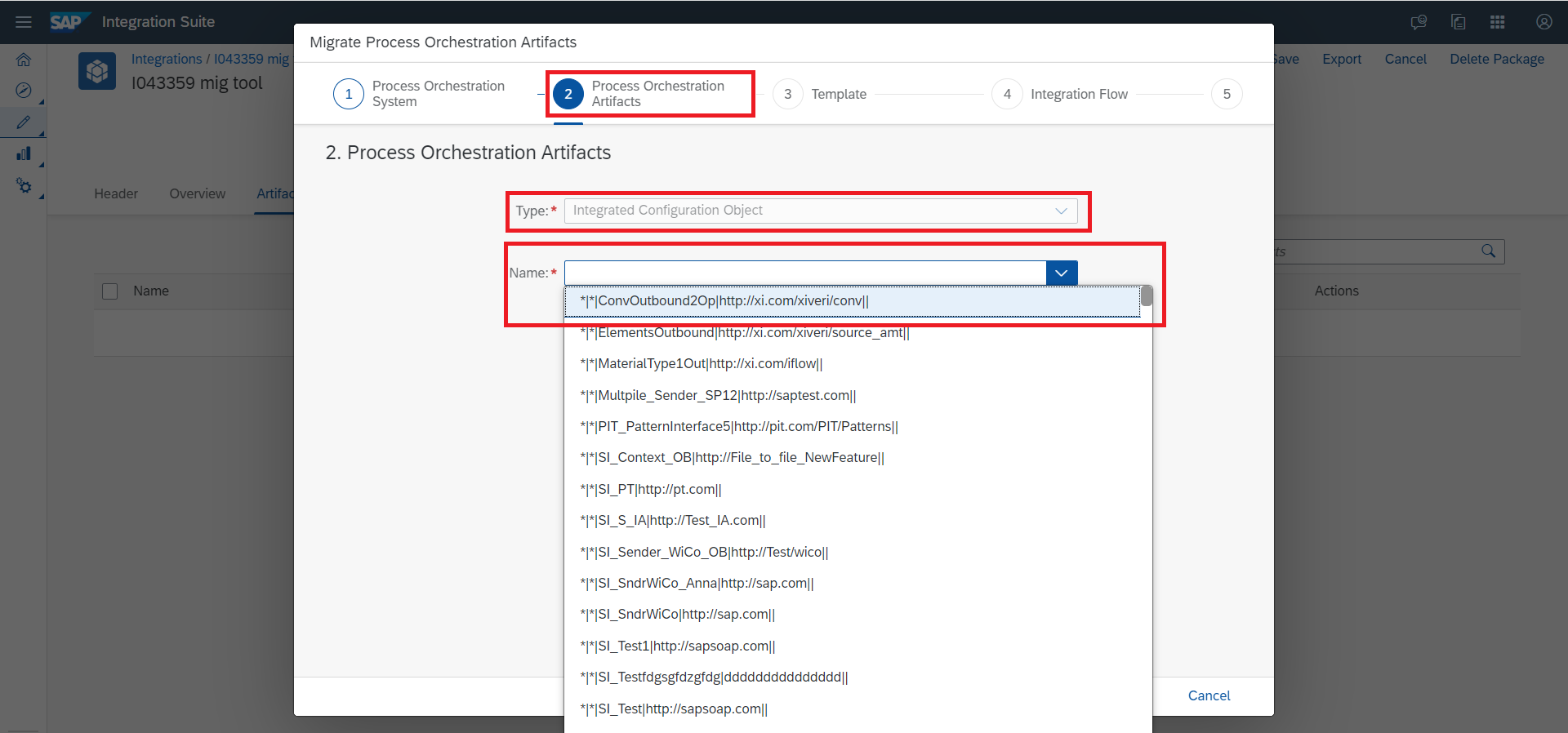
Step 7: Filter the ICOs based on the available parameters. Usually, the list of the ICOs will be huge, hence it is advisable to apply a filter. In this example, the ICO’s are filtered by applying the “Sender Communication Component” parameter. Once an ICO is selected for migration, you can click Next Step.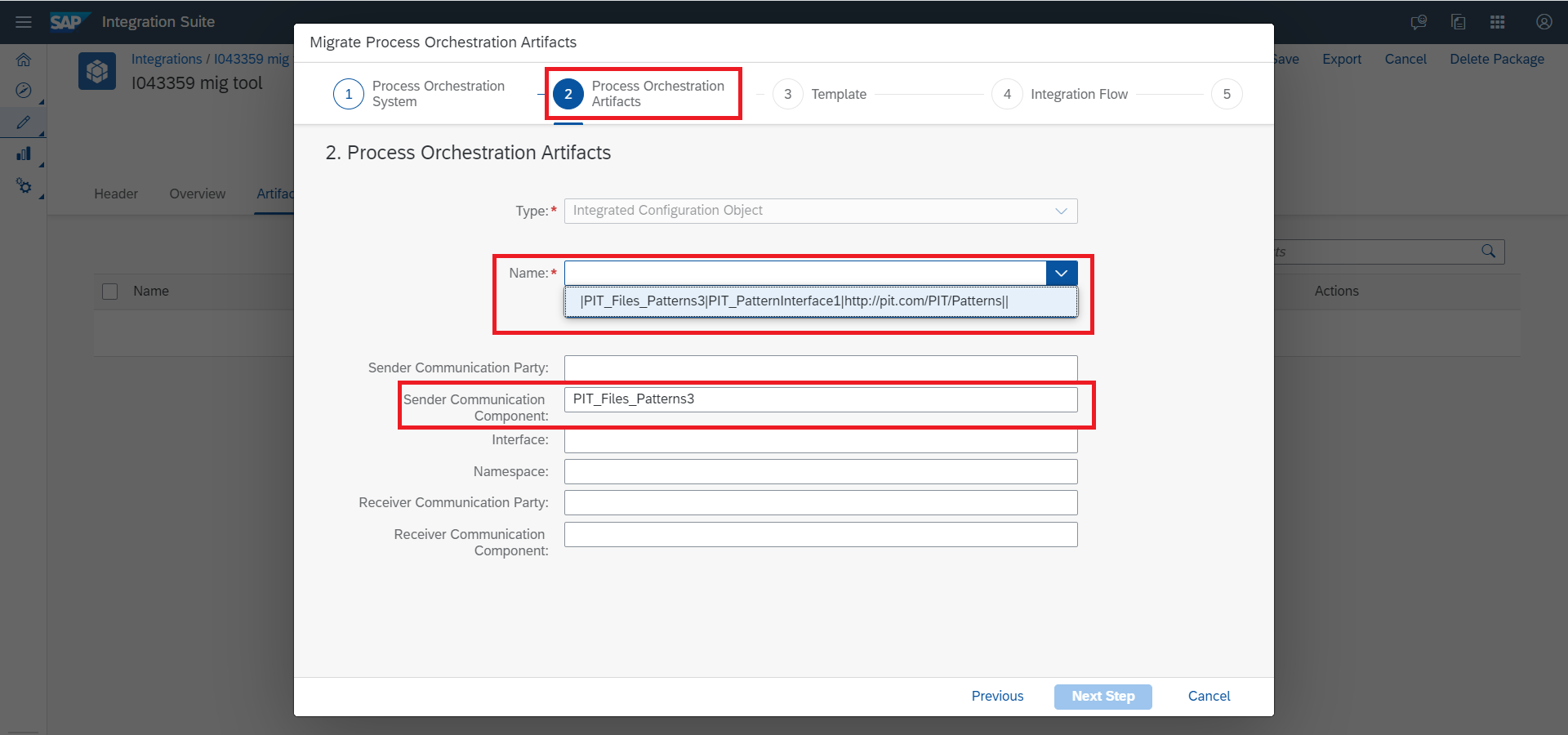
Step 8: Templates associated to the ICO are available for the selection from the drop-down list. You can select a template for the scenario migration. Context sensitive help link is available to know more about the template and how the resultant integration flow model will look like after migration.
Important point:
Every ICO that is ready for migration also has a default template. If there are no associated templates available and yet the ICO is ready for migration, the migration tooling falls back to the default template. Basically, default template creates a point-to-point integration flow; this template has neither the integration scenario nor the communication channels from the source ICO. However, mapping objects such as message mapping, XSLT mapping etc. will be copied and maintained in the point-to-point integration flow

Step 9: Provide a meaningful Integration flow name and Id in the Integration Flow tab and click Preview. The description field is auto filled with the SAP Process Orchestration system name, Scenario type and name, and Template details for future reference.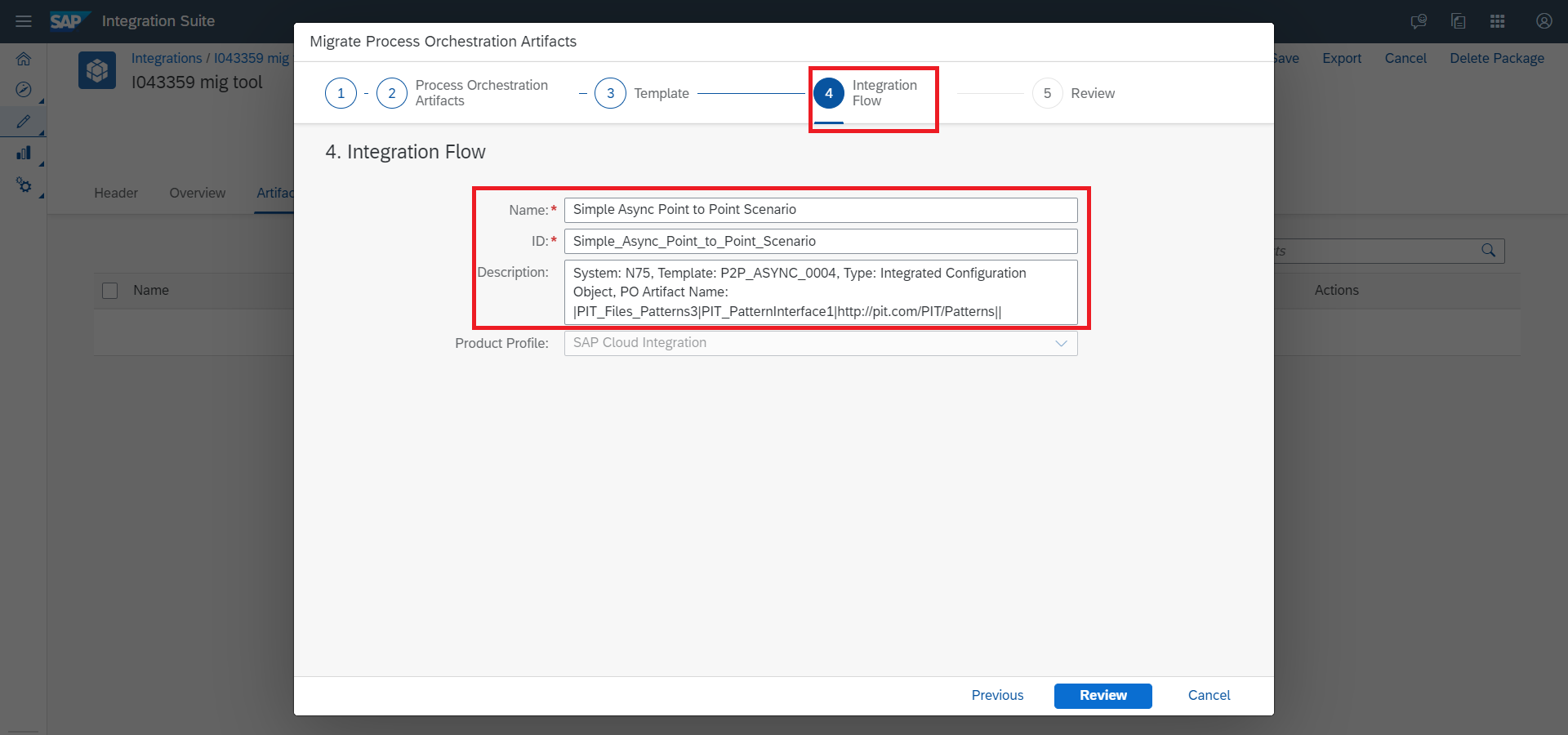
Step 10: Click the “Migration” button from the Review tab. Review the details prior to moving forward.
Step 11: After the integration scenario is successfully migrated from SAP Process Orchestration to SAP Integration suite, an Integration flow will be created in the artifact list of the package overview page.

Step 12: Open the anticipated integration flow which is created after a successful migration. In this example, a point-to-point integration flow is created having SOAP Adapter, two message mappings and one XSLT mapping.

Step 13: Certain configuration changes are required to ensure an integration flow is deployable. For example, in the Receiver SOAP Adapter, configure the proxy type as “On-Premise” and provide the associated “Location Id”.

Step 14: Select the XSLT mapping step and open the corresponding resource for verification. You can also verify the resources of the message mapping steps.
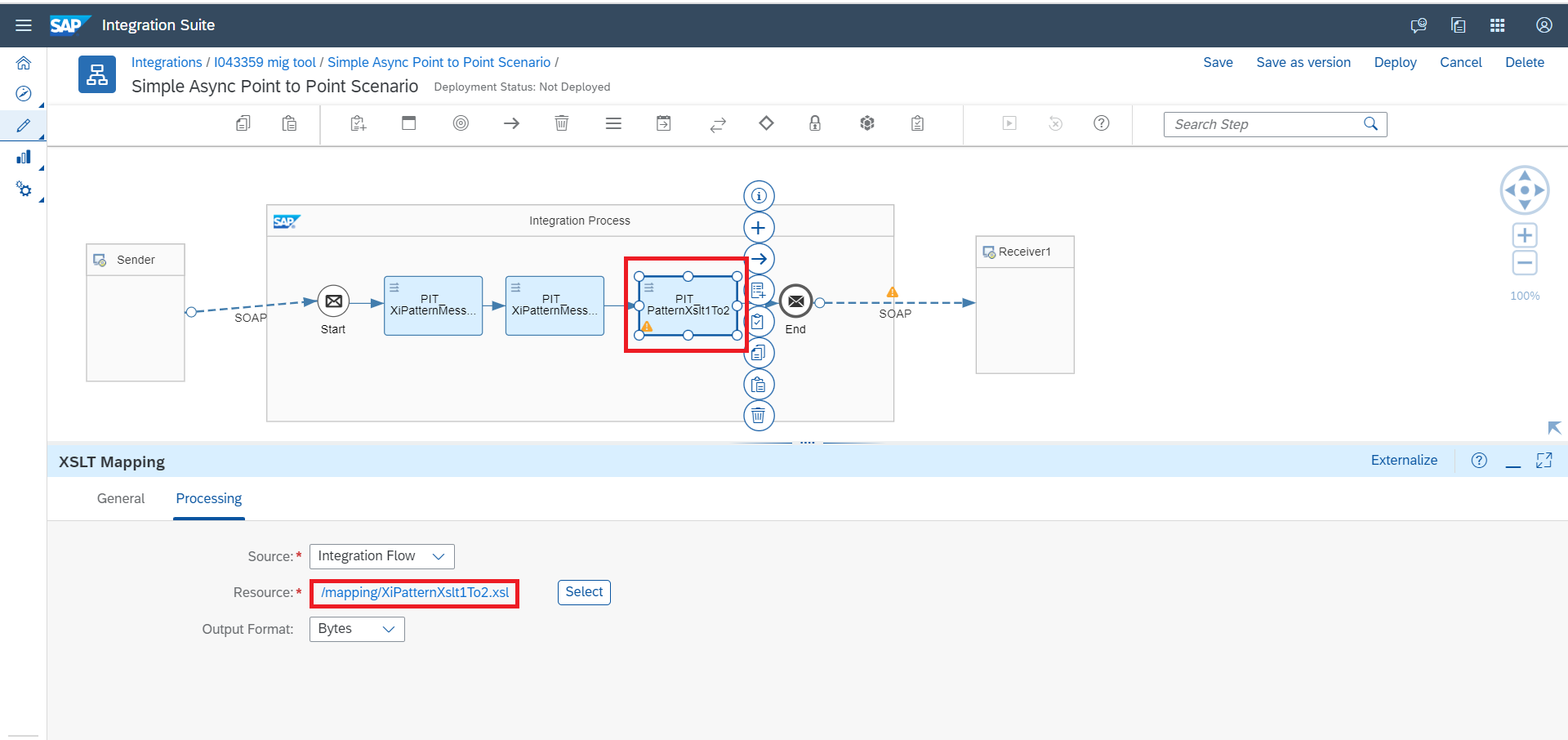
Step 15: Deploy the integration flow and trigger the endpoints as usual to process the messages. Check if the security artifacts, like credential name and key alias, that are used in your ICO are correctly configured in the integration flow. Deploy the necessary security artifacts before you deploy the integration flow.

Support components
In the current scope, the migration tooling supports the migration of ICOs that contain the following components:
- Communication Channel: HTTP, REST, SOAP, IDOC, FTP, XI and SFTP
- Events: Timer
- Flow Steps: XSLT Mapping, Message Mapping, XML to JSON Converter, JSON to XML Converter, and Router
If your ICOs contain channels, events, or flow steps that aren't mentioned here, you would require additional manual effort for the migration. However, we plan to continuously improve the tool to increase the scenario coverage. For more details, you can refer the roadmap section.
Supported Templates
Learn about the various templates that are available in the migration tooling from the documentation.
Known limitation
Know about the limitations of the migration tooling from the documentation.
Benefits
- Accelerate the migration from SAP Process Orchestration to SAP Integration Suite by reducing manual effort.
- Minimize migration errors through an automated migration process.
- Lower cost and risks of migration.
- Included in SAP Integration Suite at no additional cost.
Roadmap items
We have a plan to further improve the migration tool experience by targeting the below roadmap items. While these are part of our current plan, the roadmap may change at any time.
- Summary page on successful scenario migration to find useful information quickly and in one place.
- Support additional adapters during migration such as XI, JDBC, RFC, Mail adapters etc. and reduce the current limitation list.
- Support additional templates to cover more scenarios in migration.
- Java functional libraries support in message mappings
- Reusable message mapping and script collections support in migration.
- Support older versions of SAP Process Orchestration such as 7.4x and 7.3x.
- Support integration flow of SAP Process Orchestration in migration.
- Migrate classical scenarios .
- Mass migration to support multiple ICOs in a single migration execution.
- Migrate all the possible integration scenarios.
SAP Cloud Integration release 6.36.x
In this release of Cloud Integration of SAP Integration Suite, we have enabled the following features in the Migration Tool.
- XI Adapter is supported in the scenario migration from SAP Process Orchestration to SAP Integration Suite.
- Fixed some attributes which were not mapped properly in the scenario migration.
- Success/Summary page on successful scenario migration to find useful information and guidance on the next steps. In the success page, you will also experience the equivalent channel/adapter mappings between SAP Process Orchestration and Integration Suite, supported components and known limitations in the migration tool.

SAP Cloud Integration release 6.37.x
In this release of Cloud Integration of SAP Integration Suite, we have enabled the following features in the Migration Tool.
- All supported adapters are externalized to leverage the benefit of the externalized parameters.
- Easy way to filter the ICOs using the regular expression in the search parameters.
Regular expression (*) is enabled in the search parameters to search the ICOs. In the below example, (*) is used in the Sender Communication Component to filter ICOs. You can use (*) in either of the search parameters to ease the filtering task.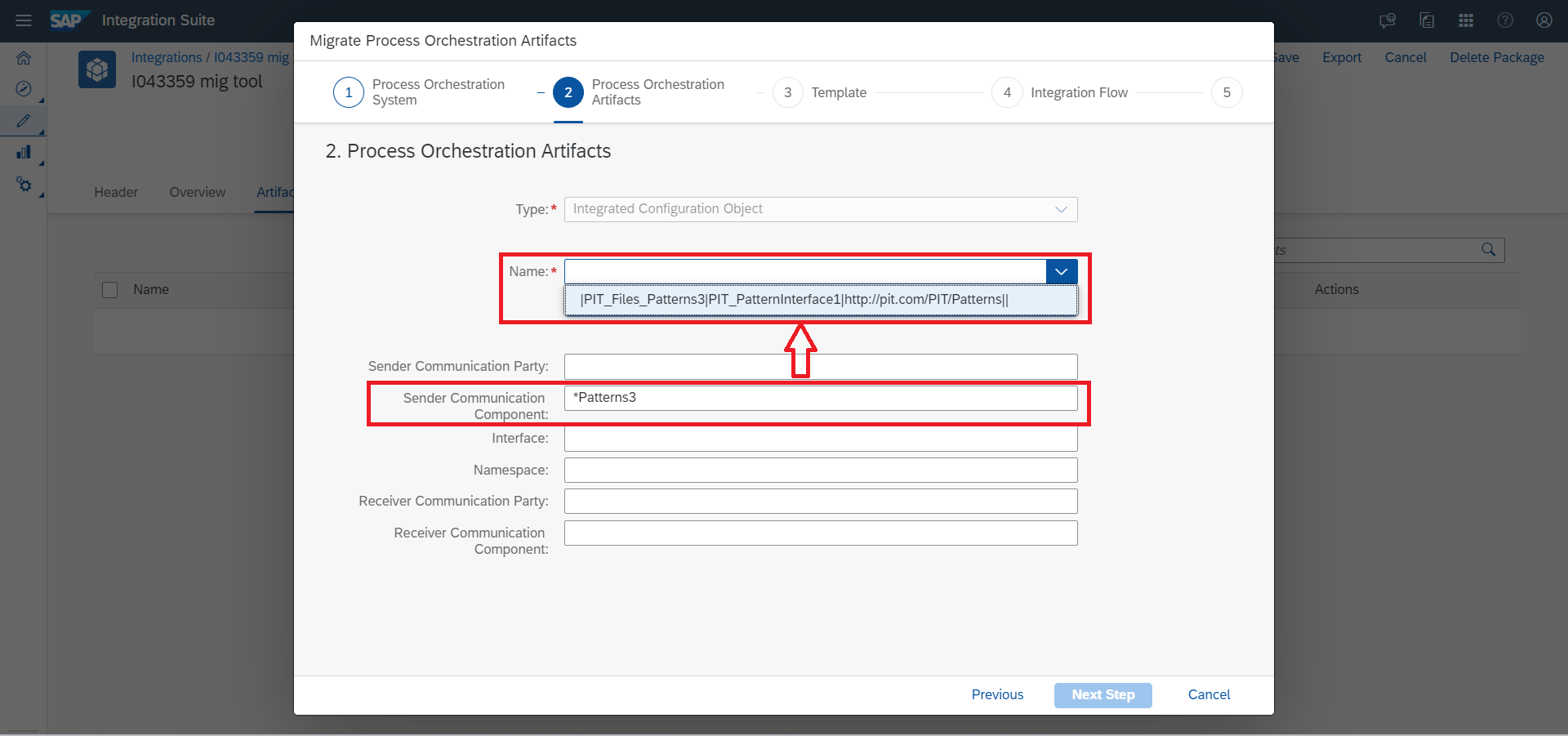
- Template definition is shown as an information which will guide user to choose an appropriate template. For more details on the template, user can click the context sensitive help link(?) which will open the corresponding template help document.
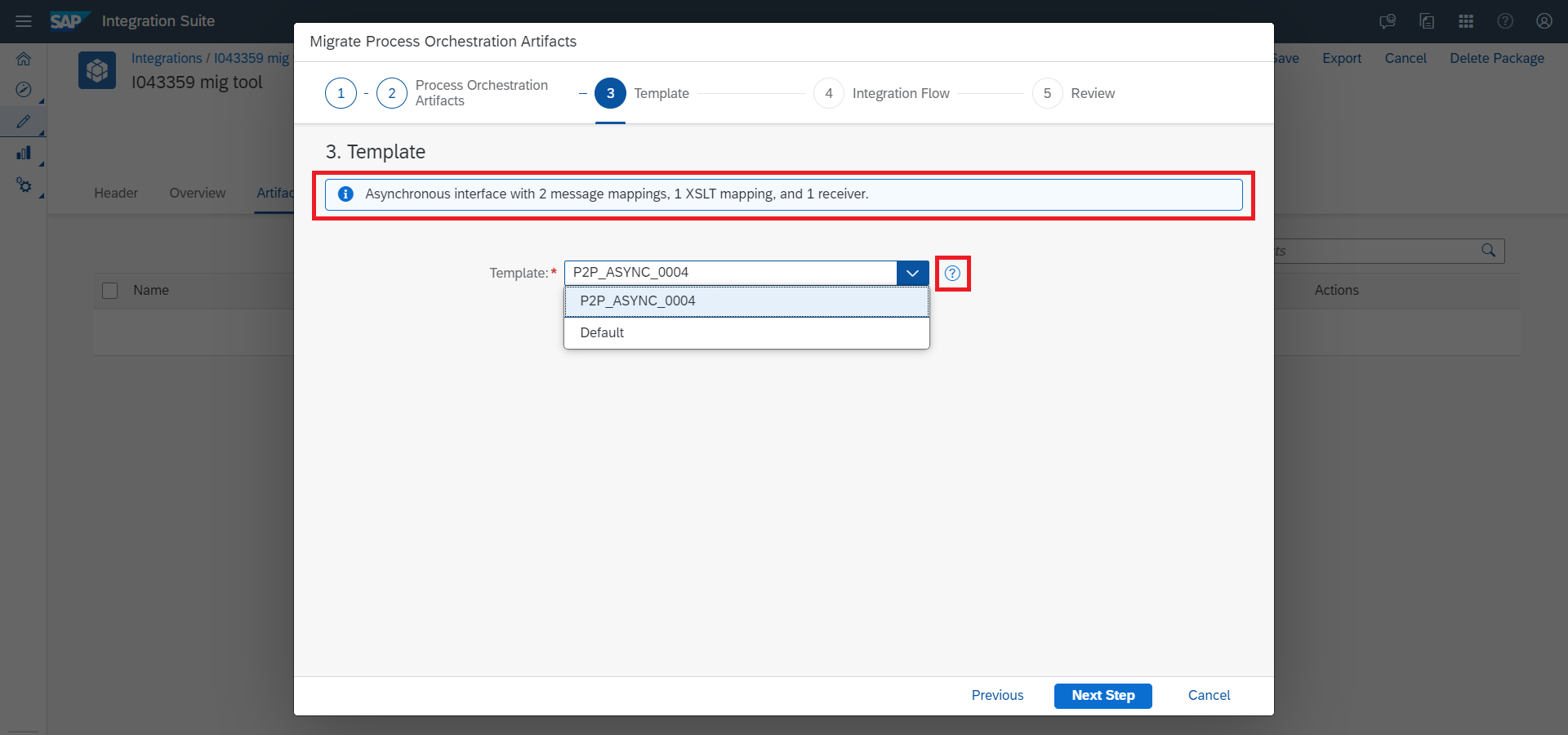
SAP Cloud Integration release 6.38.x
In this release of Cloud Integration of SAP Integration Suite, we have enabled the following features in the Migration Tool.
- RFC, JDBC Adapter is supported in the scenario migration from SAP Process Orchestration to SAP Integration Suite.
- Following CSV templates are supported in the migration tool for scenario migration. Refer the help documentation.
- P2P_ASYNC_CSV_001
- P2P_ASYNC_CSV_002
- P2P_ASYNC_CSV_003
- Modularize the integration flow model with local integration process and exception sub process. Local integration process will be used to group the mapping steps and exception sub process for graceful error handling. Refer the help documentation.
SAP Cloud Integration release 6.39.x
In this release of Cloud Integration of SAP Integration Suite, we have enabled the following features in the Migration Tool.
- Supporting Bridge Template in migration tool for scenario migration. Refer the help documentation
- P2P_ASYNC_BRIDGE_001: Point-to-Point Async-Sync Bridge between 1 sender supporting asynchronous communication and 1 receiver supporting synchronous communication with message mappings for request and response.
SAP Cloud Integration release 6.40.x
In this release of Cloud Integration of SAP Integration Suite, we have enabled the following features in the Migration Tool.
- Mail Adapter is supported in the scenario migration from SAP Process Orchestration to SAP Integration Suite.
SAP Cloud Integration release 6.41.x
In this release of Cloud Integration of SAP Integration Suite, we have enabled the following features in the Migration Tool.
- Supporting template based on the mail adapter. Refer the help documentation
- P2P_ASYNC_ATTACH_001: Point-to-Point asynchronous interface between 1 sender and 1 receiver with 1 message mapping and exchanging the incoming attachment with the message body.
- New System settings UIs to manage and maintain multiple SAP Process Orchestration systems. Refer documentation. Shortly will publish SAP blog to know more about system settings, its usage and benefits.
SAP Cloud Integration release 6.43.x
In this release of Cloud Integration of SAP Integration Suite, we have enabled the following features in the Migration Tool.
- Supporting older version of SAP Process Orchestration System in scenario migration. Refer documentation for details.
- 7.31
- 7.40
SAP Cloud Integration release 6.44.x
In this release of Cloud Integration of SAP Integration Suite, we have enabled the following features in the Migration Tool.
- Improving the coverage for scenario migration by supporting the following templates based on content-based routing and Recipient list. Refer documentation for detailed understanding on the following templates.
- Content based routing templates.
- CBR_ASYNC_001: Content Based Router with 1 router and a receiver for each router branch raising error in case of receiver not determined.
- CBR_ASYNC_002: Content Based Router with 1 router and a receiver for each router branch ignoring message in case of receiver not determined.
- CBR_ASYNC_003: Content Based Router with 1 router and a receiver for each router branch sending message to default receiver in case of receiver not determined.
- Recipient list templates
- RL_Async_001: Recipient List with option to raise an error if receiver cannot be determined.
- RL_Async_002: Recipient List with option to ignore the message if receiver cannot be determined.
- RL_Async_003: Recipient List with option to send message to default receiver in case of receiver not determined.
- Content based routing templates.
SAP Cloud Integration release 6.45.x
In this release of Cloud Integration of SAP Integration Suite, we have enabled the following features in the Migration Tool.
- OData Adapter is supported in the scenario migration from SAP Process Orchestration to SAP Integration Suite.
I hope, you can benefit from the enhancements presented in this blog post. If you have any questions or feedback, please feel free to comment on this blog.
- SAP Managed Tags:
- SAP Integration Suite
You must be a registered user to add a comment. If you've already registered, sign in. Otherwise, register and sign in.
-
ABAP CDS Views - CDC (Change Data Capture)
2 -
AI
1 -
Analyze Workload Data
1 -
BTP
1 -
Business and IT Integration
2 -
Business application stu
1 -
Business Technology Platform
1 -
Business Trends
1,658 -
Business Trends
92 -
CAP
1 -
cf
1 -
Cloud Foundry
1 -
Confluent
1 -
Customer COE Basics and Fundamentals
1 -
Customer COE Latest and Greatest
3 -
Customer Data Browser app
1 -
Data Analysis Tool
1 -
data migration
1 -
data transfer
1 -
Datasphere
2 -
Event Information
1,400 -
Event Information
66 -
Expert
1 -
Expert Insights
177 -
Expert Insights
295 -
General
1 -
Google cloud
1 -
Google Next'24
1 -
Kafka
1 -
Life at SAP
780 -
Life at SAP
13 -
Migrate your Data App
1 -
MTA
1 -
Network Performance Analysis
1 -
NodeJS
1 -
PDF
1 -
POC
1 -
Product Updates
4,577 -
Product Updates
341 -
Replication Flow
1 -
RisewithSAP
1 -
SAP BTP
1 -
SAP BTP Cloud Foundry
1 -
SAP Cloud ALM
1 -
SAP Cloud Application Programming Model
1 -
SAP Datasphere
2 -
SAP S4HANA Cloud
1 -
SAP S4HANA Migration Cockpit
1 -
Technology Updates
6,873 -
Technology Updates
419 -
Workload Fluctuations
1
- SAP Integration Suite - IDOC to flat file conversion in Technology Q&A
- Consuming SAP with SAP Build Apps - Mobile Apps for iOS and Android in Technology Blogs by SAP
- Configure SAP BTP destination REST API integration - Document information extraction - "AxiosError: in Technology Q&A
- Support for API Business Hub Enterprise in Actions Project in Technology Blogs by SAP
- Demystifying the Common Super Domain for SAP Mobile Start in Technology Blogs by SAP
| User | Count |
|---|---|
| 36 | |
| 25 | |
| 17 | |
| 13 | |
| 8 | |
| 7 | |
| 6 | |
| 6 | |
| 6 | |
| 6 |